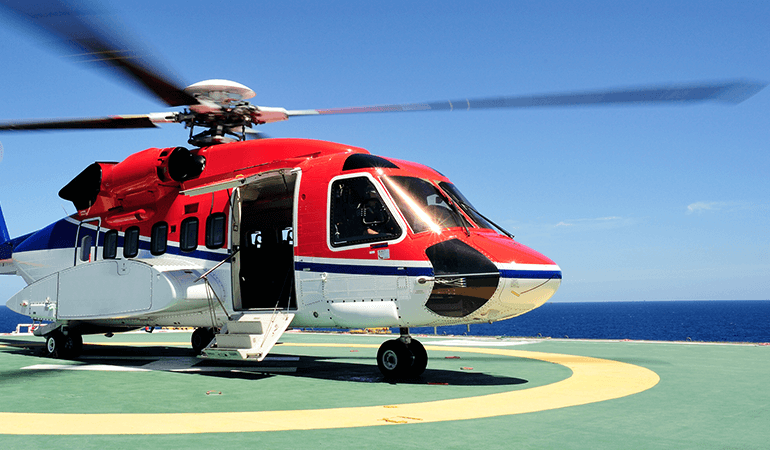The single feature that makes wheeled helicopters favorable to a fixed-wing under all circumstances is vertical takeoff and landing. If an operator does not need this capability, there is no advantage in a helicopter over a fixed-wing of comparable size and scope. A helicopter is slower, more dangerous, far less efficient, and requires a tremendous amount more power than the fixed-wing. But when you need the vertical lift, vertical takeoff, and landing, nothing in the world can replace a helicopter. Of course, having only the ability to land and take off vertically on the skids does hamper the overall capability, which is why some units run a tricycle gear much like an airplane. Let's dig a little deeper into wheeled helicopters.
Wheeled Helicopters: A History
The wheeled helicopter concept is not a new one; some of the more successful early helicopters were wheeled designs. The Sikorsky R-4 Hoverfly, which was the first commercially mass-produced helicopter globally, was a wheeled design.
Particularly on these early helicopter designs, using wheels was prevalent, and for a couple of reasons. For one thing, it was the most straightforward transition since the design was already in use on fixed-wing aircraft. There is nothing inherently wrong with using wheels on helicopters. It is a proven design, and the parts were readily available. But early on, there was another reason why helicopters needed wheels: they were underpowered.
Turbine engines were in development at almost the exact time as helicopters. Still, they were not a viable option yet, nor were they commercially available, so helicopters had to rely on what was readily available, which were air-cooled reciprocating engines. These engines are great for fixed-wing aircraft, and they still power several of the smallest helicopters, namely the Robinson R22 and R44 helicopters, as well as the Schweizer 269, 300, and a host of homebuilt Experimental-category helicopters. But these engines are just too heavy with too little power production for anything beyond micro helicopters. So the earliest helicopters would understandably struggle as they neared maximum gross weights, especially if density altitude was high and outside air temperatures were high.
Operating on wheels allowed helicopters to get into an effective translational lift with rolling forward motion, which significantly improved performance. Of course, it largely defeated the purpose of a vertical lifting aircraft if it could only lift vertically at near-empty gross weights.
The UH-1 Iroquois (“Huey” to everyone), or Bell 204/205 in the civilian community, was the first successful helicopter to be manufactured with an exclusive turboshaft power plant of a piston engine. It proved to be powerful enough to operate with ease on the skids in the extreme jungle environments of Vietnam without the necessity of a run-up to get into the translational lift. During the Vietnam-era and post-Vietnam era, wheeled landing gear on helicopters was reserved for medium-lift and heavy-lift designs. The most noteworthy examples of these are the Sikorsky CH-53 Stallion series, the Boeing CH-46 and CH-47 variants, Russian Mil Mi-6 and Mi-26, among many others.
Operational Considerations for wheeled and skidded helicopters
There are a few reasons why a helicopter has wheeled landing gear over skids. Now skids have the advantage in terms of cost efficiency; a set of skids requires truly little maintenance, has zero moving parts, does not need to have hydraulic fluid or gaseous nitrogen serviced, and is much cheaper to produce. They also are streamlined on modern helicopters to air in aerodynamic efficiency. However, skids require the aircraft to be under hover power for all ground movements. Ground movements under power create downwash, which poses a risk to other aircraft and personnel with FOD being tossed around.
Helicopters on the skids pose a ground-handling conundrum, too. Since they can only taxi under power, they must have some apparatus available for ground movement. Some helicopters use wheel dollies that attach to the skids for unpowered ground movement into and out of hangars. Another popular option is to have a wheeled platform on which the helicopter lands and takes off on and the entire platform is towed with a tractor.
A skid landing gear system is only an option for lightweight helicopters. Medium and heavy helicopters are far too powerful and heavy for skids; a light helicopter can be a nuisance under hover power, but a heavy helicopter is downright dangerous; the downwash at hover goes out and up hundreds of feet and can easily overturn parked aircraft.
Ground Handling of Large Helicopters
Modern large helicopters are engineering marvels; the max gross takeoff weight of a Sikorsky S-65 (CH-53) is in the ballpark of 42,000lbs; a fully loaded Boeing CH-47 weighs in at a very hefty 50,000lbs. And of course, the infamous Mil Mi-26 weighs in at over 120,000lbs fully loaded, which is very nearly the maximum takeoff weight of a Boeing 737-200! The ‘lighter’ helicopters previously mentioned having MTOW, which is about double that of an Embraer ERJ-145 commuter, just for reference. The significance of this being that operators must plan accordingly for ground handling; you cannot only expect to hook up any tug and expect it to be an adequate piece of machinery for these modern marvels.
They are a lot more like a medium jet on the ground than a small helicopter. While not used in the USA, the Mi-26 was as heavy as a B737, but at over 130’ in length, it is longer than an Airbus A320.
Maneuvering Wheeled Helicopters in Unconventional Situations
Wheeled helicopters do not lose their ability to take off and land vertically; if anything, having wheels only enhances their capabilities. One of the most common tasks for a helicopter is executive transport. Among the most popular helicopters for this duty are the Sikorsky S-76, the Augusta Westland AW139, and the AS365 Dolphin, all of which are wheeled.
These helicopters are commonly used in all sorts of personnel transport, especially VIP transport, which includes any number of environments. Still, they are ubiquitous for open water transport, of which oil rigs are particularly common. While there are several light helicopters on skids that do this chore, their wheeled brethren are pressed into service much of the time. Helicopters are also standard in transporting personnel to and from commercial ships.
The complication is when these heavier medium helicopters are parked on the oil rig or on the vessel. Oil rigs sometimes have room for multiple aircraft, or the aircraft needs to be repositioned for whatever reason. Let's be very frank right now: a Sikorsky S-76 has an empty weight of around 7,000lbs and a maximum gross weight of nearly 12,000lbs. This ordinary helicopter weighs between four and six tons when it lands, and it may be on a pitching deck on a ship or an oil rig platform. Unlike a sprightly Bell 206, which will land no heavier than about 3,300lbs, you cannot just hook up a towbar to an S-76 and walk it around by manpower, at least not very well. Also, unless you have someone on the brakes, you certainly could not push it very safely under those circumstances.
It would help if you had the right tool for every job, and the right tool is a tug that is impervious to the elements. It would be best if you had a tug that is heavy enough to control the aircraft's movement, not vice versa. A Mototok tug is an excellent solution as it is made to be watertight. They are ultra-compact and very low profile, so storage is a cinch. With an entry-level model having a 39-ton capacity, you will not lack power for anything until the Mi-26 (and yes, there is a model for that size of the helicopter, too.)
Why A Remote Tug?
A traditional tractor-style tug is becoming largely obsolete and nowhere more so than the extremely cramped quarters of an offshore rig or a ship. For one thing, ships other than aircraft carriers have no deck space for a large tug and towbar. A tractor with a towbar downright will not work on those movement surfaces because there is simply no room for them to maneuver as they are designed to do. A tractor has multiple pivot points and must have room to handle, and that is just not possible on a landing pad. Whereas a remote-controlled tug has no pivot points at all, it turns the nose landing gear to go as far as the stops on the aircraft will allow. If the aircraft enables a 90-degree turn on the nose gear, a remote-controlled tug can accommodate it.
Second, where would you store such a thing? The unit's overall length, including a towbar, is going to be nearing 30' (around 10 meters) and are several feet tall. A remote-controlled tug is much shorter in length and very low in overall height, so it is easily stored. Plus, there is no need to keep fuel stores on supply for a GSE as the remote-controlled tug is fully electric and needs a plugin to operate.
Conclusion to wheeled helicopters
Helicopters are indeed a modern marvel, with the largest example weighing anywhere from 25-tons to 60-tons fully loaded. The machines have far outgrown the ability to use the common skid platform. Their ground handling characteristics are much more akin to that of a small-to-medium airliner than that of a small utility helicopter. Your operation should upgrade to modern tugs that are up to safely moving these aircraft, whatever the weather, anytime, anywhere.
Looking for a helicopter tug? Get in touch right now and find out how Mototok can provide the right tug for you!


Comments